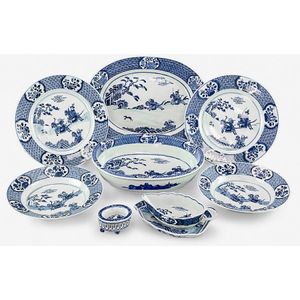Chinese Seal Paste Boxes from Qing to Republic Period
You must be a subscriber, and be logged in to view price and dealer details.
Subscribe Now to view actual auction price for this item
When you subscribe, you have the option of setting the currency in which to display prices to $Au, $US, $NZ or Stg.
- Ming Dynasty - The Ming Dynasty was a ruling dynasty of China from 1368 to 1644. It succeeded the Yuan Dynasty and preceded the Qing Dynasty. The Ming Dynasty was established by Zhu Yuanzhang, a former Buddhist monk who became a rebel leader and eventually overthrew the Mongol Yuan Dynasty. During the Ming Dynasty, China experienced a period of relative stability and prosperity. The government was centralized and bureaucratic, with the emperor at the top of the hierarchy. The Ming Dynasty is known for its cultural achievements, including the development of porcelain, the invention of movable type printing, and the construction of the Great Wall of China.
- Jiajing Mark - The Jiajing mark on Chinese porcelain refers to the reign mark of the Jiajing Emperor (r. 1521-1567) of the Ming Dynasty in China. The mark usually appears as six characters in underglaze blue on the base of the porcelain object and indicates that the object was made during the Jiajing period of the Ming Dynasty.
The Jiajing reign was a time of great artistic production and experimentation in China, particularly in the field of porcelain. The Jiajing Emperor was a patron of the arts and his reign saw the development of new decorative techniques and styles, including the use of underglaze blue decoration, which became a hallmark of Ming Dynasty porcelain.
It should be noted that not all porcelain objects with a Jiajing mark are necessarily from the Jiajing period, as the mark has been copied and imitated by later generations of potters. - Qing Dynasty - The Qing Dynasty was the last imperial dynasty of China, ruling from 1644 to 1912. It was established by the Manchu people, who originated from the northeastern region of China. The Qing Dynasty was preceded by the Ming Dynasty and followed by the Republic of China.
- Republic Period - The Chinese Republic period, also known as the Republic of China period, lasted from 1912 to 1949. It began with the overthrow of the Qing Dynasty in 1911 and the establishment of the Republic of China under Sun Yat-sen. During this period, the country underwent significant political, social, and economic changes, including the adoption of a new constitution, the expansion of civil liberties, and the modernization of the economy. However, the Republic of China period was also marked by political instability, with numerous warlords and factions vying for power and influence, and the country was eventually engulfed in a civil war between the Nationalists and the Communists. The Republic of China period came to an end in 1949, when the Communists emerged victorious and established the People's Republic of China, while the Nationalists retreated to Taiwan where they established a separate government.
This item has been included into following indexes:
- Chinese ceramics, dynasty mark or period
- Chinese ceramics, item type
Visually similar items

Pair of Chinese Qianlong porcelain wine cups and saucers, decorated with water birds perched upon rocky outcrops and flowers, in tones of turquoise, yellow and green, with original gallery label, height 4.5 cm (4). Purchased: Geoffrey Waters, London

Chinese export Kangxi-style blue and white partial dinner service, 19th century, including: seven dinner plates, fourteen side plates, two large plates, four deep plates, eight soup plates, one tureen, three graduated oval platters, one gravy boat, one spo

Two 18th/19th century Chinese export plates, blue and white decoration. Hair cracks.

A collection of six Chinese famille rose enamelled plates. 16.5 cm diameter
